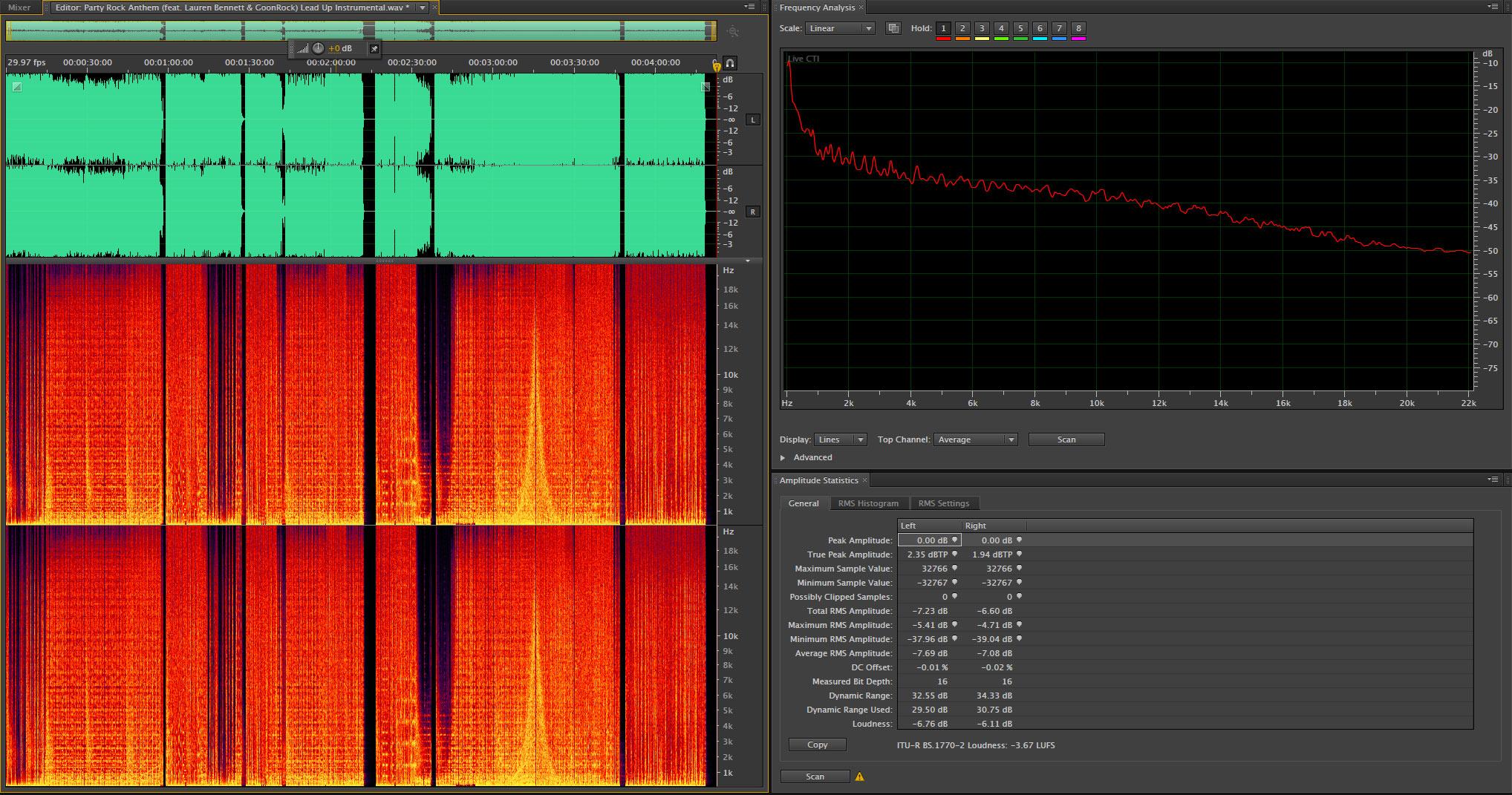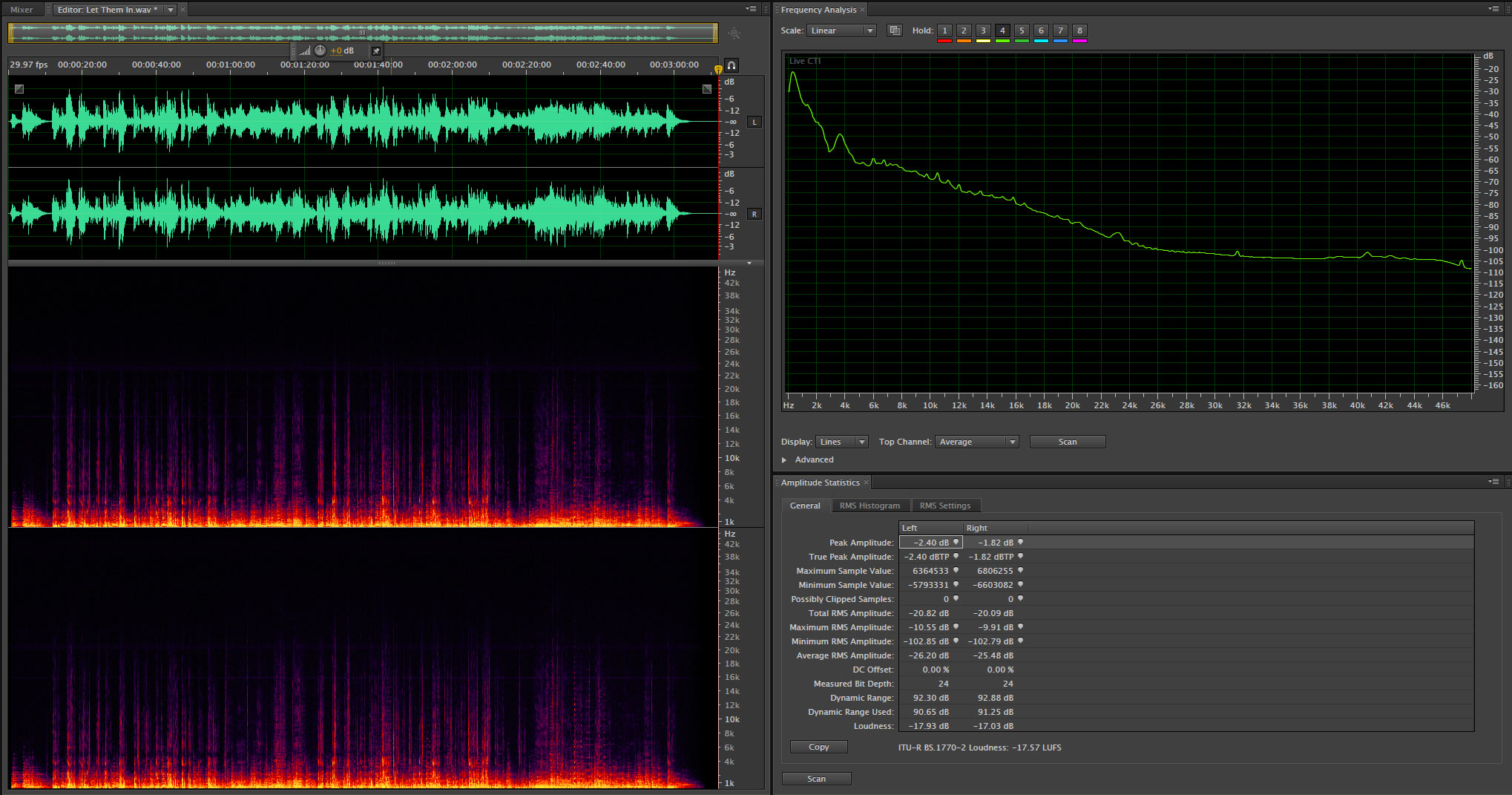Return From Oz
It was a very brief trip to the center of the country to spend an hour giving a quick primer about the emerging world of high-resolution audio to a very diverse group of technicians, executives and marketing folks. The presentation was followed by a demonstration of some really wonderful recordings. And it was the only time I’ve ever played “Party Rock Anthem” by LMFAO as part of a presentation.
I had planned to go quickly through the “Music, Audio and High-Fidelity” Q&A pages that I posted over the past couple of days, but as it turned out time was a little pinched and I trimmed down my talk a bit. The essential message to the group was that better music fidelity is now available on portable devices and at home. Music lovers do not have to compromise on fidelity when they’re on the go any longer.
When it was my turn at the podium, I plugged in my Mac Laptop and displayed a spectrogram of “Party Rock Anthem”, which I had discovered was on my computer. No, this tune is not part of my usual listening but was part of a collection of tracks that I use in my music production class. I make available the isolated vocal tracks to my students and have them produce a new track for them. It’s a great exercise and the stuff they come up with is very innovative and compelling. I’ve heard Snoop Dog accompanied by a string quartet and Ringo Starr singing “A Little Help From My Friends” to an all-electronic instrumental track. Amazing.
So knowing that a picture is worth a thousand words, I ran an analysis on “Party Rock Anthem”. The spectrum is below:
Figure 1 – The spectrum of “Party Rock Anthem” by LMFAO. [Click to enlarge]
By now we already know what to expect with a top commercial hit like “Party Rock”. The waveform shows the plateaus that result from heavy-handed mastering and the spectrum itself shows insane amounts of sound energy across the entire frequency spectrum. I showed this to the group as an example of a typical commercial track. There are valid reasons why the artists, producers, engineers and label did what they did to this track. Honestly, I don’t fault them for releasing a song that sounds like a brick…all loud all of the time. It’s part of the genre. It would be very interesting to see what the reaction would be if the track weren’t pumped up so much. I’m sure this is what the artists wanted to release…this track is not about the emotional connections we feel with music, it was to get you off your tailbone and dancing. It succeeded! Although, I remained in my seat on the plane as I listened to “Party Rock Anthem”.
Then I shared a track that exhibited a different approach to music production. I shared the “Let Them In” track by John Gorka. Here’s the spectrum of that track.
Figure 2 – The spectrum of “Let Them In” by John Gorka. [Click to enlarge]
It’s pretty obvious that these two tracks come from different ends of the production spectrum. There are reasons why both are valid and appropriate. But as I discussed in my brief presentation, finding tracks that have the dynamic range and frequency realities of an AIX Records recording is very hard. It’s also important to recognize that you can smash the emotional energy out of the John Gorka track by mastering it to death but you can’t get back to the “emotional” version of “Party Rock Anthem”.
I believe I made my point about dynamics in music and the assembled group understood the basic concept. After a short break, we reconvened across the hall in another conference room and listened to a variety of tracks from AIX and others on a really terrific system. Once you hear it…you know.
It’s good to be back in my office. I’m more energized than ever about the prospects for ultra high-definition audio.




Hi Mark,
I am listening to Michael Fremer on Scott Wilkinson’s Home Theater Geeks podcast # 215. I just heard Michael say that there is information on vinyl going up to 50kHz and above. The discussion starts at about 18:30 of the show. He also mentions something about a pilot tone on vinyl used for quadraphonic recordings at 50kHz. After hearing this my question is, does this mean there is anything meaningful on the vinyl above 20kHz or is this a mischaracterization of what he has “seen” in a spectral analysis? It would appear to me that not all the components in the analog chain are capable of recording or playback of these frequencies. I guess in the case of quad it would be possible to superimpose a 50kHz tone on the music but I don’t know that for certain.
Thanks and keep up the informative post.
Best regards,
Brian
Michael is a very knowledgeable gentleman about vinyl but I believe he’s misinformed on the practical aspects of record production. I’ve talked about this previously but let me give you the quick answer. Is it possible for a 50 kHz tone to exist on a piece of vinyl spinning at 33 1/3 RPM? Maybe. Does it actually happen in the world of record production and distribution? No. Recording engineers are not recording with microphones that have the ability to capture anything above around 20-30 kHz…especially back in the “good old analog tape days”. And the analog 24-track 2″ tape machines didn’t record frequencies much beyond 30 kHz…and the levels were down considerably at that frequency. All of the subsequent production stages (mixing, mastering etc) reduced any chance that a 50 kHz tone would ever make it to a replicated piece of vinyl. So while under laboratory conditions, Michael might be safe to make that claim…in reality it’s a pipedream.
The pilot tone in quad is another misrepresentation. Yes, there was a matrixed system used to capture 4 discrete channels on a stereo format but the level of the pilot tone was way down there in amplitude.
Vinyl LPs cannot deliver the accuracy, the dynamics, and the frequencies of a live performance. People might rave about the sound but it’s nothing like a well made PCM high-resolution recording or even a well done CD!
Seems dynamic compression is going strong in live concerts too. Went to a Peter Frampton & Doobie Brothers concert last night in Atlanta.
The sound from Frampton’s band was decent. GREAT performance, but about what you’d expect for concert SQ.
The sound for the Doobie Brothers was another story. The DB sound guys heavily compressed/limited the signals from all sources and then drove the speakers to the low end of distortion. The overall sound was very “hard” with vocals very “crunchy”. I found it difficult to understand some of the very well-known lyrics, but the crowd seemed to love the “modern” sound. Pretty much ruined a potentially good show.
Dynamic compression is everywhere. It’s a tool that has become a fixture in almost all music and sound reproduction.